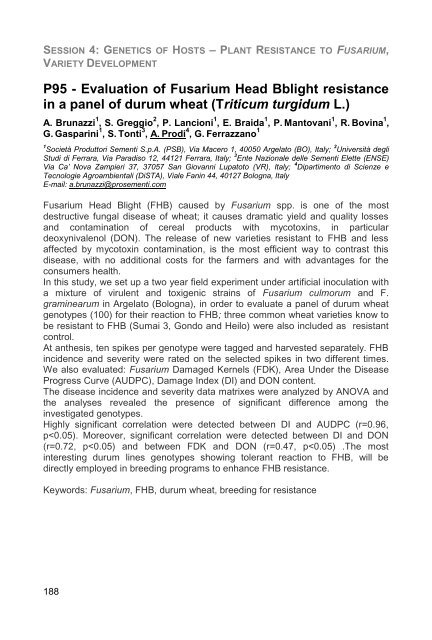EFS12- Book of abstracts - Contact
EFS12- Book of abstracts - Contact
EFS12- Book of abstracts - Contact
Create successful ePaper yourself
Turn your PDF publications into a flip-book with our unique Google optimized e-Paper software.
SESSION 4: GENETICS OF HOSTS – PLANT RESISTANCE TO FUSARIUM,<br />
VARIETY DEVELOPMENT<br />
P95 - Evaluation <strong>of</strong> Fusarium Head Bblight resistance<br />
in a panel <strong>of</strong> durum wheat (Triticum turgidum L.)<br />
A. Brunazzi 1 , S. Greggio 2 , P. Lancioni 1 , E. Braida 1 , P. Mantovani 1 , R. Bovina 1 ,<br />
G. Gasparini 1 , S. Tonti 3 , A. Prodi 4 , G. Ferrazzano 1<br />
1 Società Produttori Sementi S.p.A. (PSB), Via Macero 1, 40050 Argelato (BO), Italy; 2 Università degli<br />
Studi di Ferrara, Via Paradiso 12, 44121 Ferrara, Italy; 3 Ente Nazionale delle Sementi Elette (ENSE)<br />
Via Ca’ Nova Zampieri 37, 37057 San Giovanni Lupatoto (VR), Italy; 4 Dipartimento di Scienze e<br />
Tecnologie Agroambientali (DiSTA), Viale Fanin 44, 40127 Bologna, Italy<br />
E-mail: a.brunazzi@prosementi.com<br />
Fusarium Head Blight (FHB) caused by Fusarium spp. is one <strong>of</strong> the most<br />
destructive fungal disease <strong>of</strong> wheat; it causes dramatic yield and quality losses<br />
and contamination <strong>of</strong> cereal products with mycotoxins, in particular<br />
deoxynivalenol (DON). The release <strong>of</strong> new varieties resistant to FHB and less<br />
affected by mycotoxin contamination, is the most efficient way to contrast this<br />
disease, with no additional costs for the farmers and with advantages for the<br />
consumers health.<br />
In this study, we set up a two year field experiment under artificial inoculation with<br />
a mixture <strong>of</strong> virulent and toxigenic strains <strong>of</strong> Fusarium culmorum and F.<br />
graminearum in Argelato (Bologna), in order to evaluate a panel <strong>of</strong> durum wheat<br />
genotypes (100) for their reaction to FHB; three common wheat varieties know to<br />
be resistant to FHB (Sumai 3, Gondo and Heilo) were also included as resistant<br />
control.<br />
At anthesis, ten spikes per genotype were tagged and harvested separately. FHB<br />
incidence and severity were rated on the selected spikes in two different times.<br />
We also evaluated: Fusarium Damaged Kernels (FDK), Area Under the Disease<br />
Progress Curve (AUDPC), Damage Index (DI) and DON content.<br />
The disease incidence and severity data matrixes were analyzed by ANOVA and<br />
the analyses revealed the presence <strong>of</strong> significant difference among the<br />
investigated genotypes.<br />
Highly significant correlation were detected between DI and AUDPC (r=0.96,<br />
p
















![Présentation CRB-anim [Mode de compatibilité] - Inra](https://img.yumpu.com/17418636/1/190x135/presentation-crb-anim-mode-de-compatibilite-inra.jpg?quality=85)